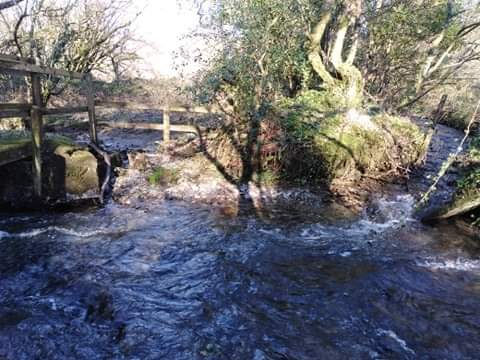Citizen Science in Frenni Fawr Woods
- Louise Cartwright

- Nov 16, 2020
- 4 min read
Introducing Frenni Fawr Wood

Frenni Fawr, known by some as Brynnan Mawr, is an iconic feature in the landscape of North East Pembrokeshire. Rising to 395 metres above sea level, the hill is home to numerous cairns, barrows, and folklore, some of which involves the Tylwyth Teg.
However, if you happen to walk on the west side of the Frenni Fawr, you’ll notice habitat, which at first glance looks like overgrown bracken or gorse. Upon closer inspection, you’ll realise that you’re gazing at extremely stunted oak trees, so small, that you’re able to touch the canopy.

This oak woodland extends to an altitude of 375 metres, it is the highest semi-natural woodland in Pembrokeshire, 180 metres higher than Ty Canol, Pembrokeshire’s only other upland oakwood. Little is known about the Frenni Fawr woodland, it seems to have been forgotten by regulatory bodies. There is no record of it in the Ancient Woodland Inventory, although it certainly appears to be ancient, with uncertainty and conjecture around the oaks stunted growth. Why are the oaks so small? In the absence of acorns, do these trees clone themselves to regenerate? What is causing the main stems to die back?

To answer some of these questions and ask a few more, a group of intrepid citizen scientists ascended the summit of the Frenni Fawr on a fine October morning in 2020. Their purpose, to take part in Growing Better Connections’ first ever citizen science activity, in collaboration with the aptly named ‘Frenni Fawr Research Group (FFRG for short).
The Frenni Fawr Plan
FFRG, a group of like-minded environmental experts, are working to ensure Frenni Fawr’s upland oak woodland achieves the appreciation it deserves. To become a recognised and conserved habitat area. FFRG believe the ancient woodland characteristics, combined with the unusual growth forms, as well as the differing age classes, make this wood a unique and interesting habitat for study. Growing Better Connections are working collaboratively with FFRG to measure different variables across the oak woodland. With plans to coordinate a series of citizen science events, where relevant data is collected, through a variety of sampling methods. The results of which, will help us put forward a strong case to achieve ‘Ancient Woodland’ classification.
Activities to Date

On 13th October 2020, our group collected oak leaves and acorns from the woodland, in an attempt to answer the question “In the absence of acorns, do these trees clone themselves to regenerate?” as well as propagate some of the valuable acorns found. FFRG member and Aberystwyth PHD student Becki Bristow led the activity. Her aims for the session were to collect leaf ‘samples’ and introduce the importance of implementing a robust sampling design.

To do this the group were split into 4. The 1st group collected leaves from the expected oak clones, the 2nd the non-expected clones and groups 3 and 4 sampled leaves from the wider woodland. During the activity, Becki taught us about our two native oak species, sessile and pedunculate oak. She explained the biodiversity these trees harness- 2,300 species are associated with oak in Britain alone, and the ability of these species to hybridise producing what’s known as ‘intermediate offspring’. This uncertainty in species composition, provided justification for our sampling, as it was evident that we needed to determine exactly what the population structure of the woodland was. Becki also highlighted how species can be misidentified and clarified why DNA analysis is sometimes needed for certain species.

Just under a month later, on the 11th November, some of the original citizen scientists and many more, congregated at Scolton Manor Tree Nursery in Spittal near Haverfordwest. Tree expert, propagation specialist and avid horticulturalist Simon Richards, taught us how to propagate the acorns we collected on the Frenni Fawr. He shared his 'Top Tips' for tree seed propagation as well as outlining the 'Scolton Manor' story.

Plans for the Future
Growing Better Connections are working closely with FFRG to design further citizen science sampling activities in the Frenni Fawr Woodland. Watch this space, but plans are afoot for both fungal and soil sampling sessions in the new year.
Becki will be sharing the results of her DNA analysis with us to determine a) if the oaks leaves sampled are in fact clones and b) it the oaks are hybridised.
The acorns sown in Scolton Manor, will be grown in the tree nursery for two years. When they are ready to plant out, these saplings will be returned to the Frenni Fawr to expand habitat connections linking the woodland with the wider habitat network.
Further Information & Interesting Research
The FFRG submitted an application in April 2021 to Natural Resources Wales to reclassify the Frenni Fawr Oak Woodland as an Ancient Woodland Site'. You can read the report here.
FFRG member and well-respected local ecologist Jon Hudson wrote a research paper on the Frenni Fawr woodland titled · ‘FRENNI FAWR – AN EXTREME EXAMPLE OF GRAZED “UPLAND” OAK WOOD’,
Becki Bristow wrote an information sheet titled 'NATIVE BRITISH OAKS HOW TO ID?', for the citizen science activity and wrote a Q&A INFORMATION SHEET, based on questions asked during the activity,
GBC worked with Steve Potter, local author of The Quarterly Journal of Forestry (Vol.88 No. 1 Jan 1994), "Practical Methods for distinguishing the two native oaks and their intermediates." Analysing 225 leaves from 15 trees, assessing: leaf character score, number of lobes and petiole length as a percentage of lamina length. This study revealed the strong expression of Quercus robur (pedunculate oak) genetic traits, with a few hybrid intermediates. This is interesting as Quercus petraea (sessile oak) is more common in Wales, and high elevation Q. robur woodlands such as this are very rare in the UK.



Comments